The Toophan (Persian: طوفان "Storm", rarely Toofan) is an Iranian SACLOS anti-tank guided missile reverse-engineered from the United States of America BGM-71 TOW missile. The Toophan 1, an unlicensed copy of the BGM-71A TOW missile, began mass production in 1988 and the Toophan 2, a BGM-71C ITOW variant, was publicly shown in 2000. The Toophan comes in at least 11 variants, many of which are poorly documented, including variants with laser guidance, thermobaric warheads, and tandem-warheads with increased penetration. The Toophan is manufactured jointly by the Aerospace Industries Organization of Iran and Iran Electronics Industries. It's normally deployed from ground-based tripods, and can also be mounted on fighting vehicles and helicopters. Like the BGM-71 TOW missile, the Toophan is a large, rugged, powerful, and reliable anti-tank guided missile deployed by small teams against tanks, armored vehicles, buildings, and other targets. The Toophan forms the backbone of the Iranian Armed Forces's ATGM inventory and is procured in large quantities in a variety of variants. The Toophan has been exported to the governments of Iraq and Syria and to a large number of non-state actors in the Middle East, and has been used in the Iran–Iraq War, the 2006 Lebanon War and the Iraqi, Syrian, and Yemeni Civil Wars.
- guided missile
- toophan
- toofan
1. Development
Iran was among the earliest countries to import the TOW missile, as far back as 1971. Extensive repair and assembly facilities were set up at the Iran Electronics Industries (IEI) by the Texas-based Emerson Energy Systems, as well as Hughes Missile Systems, to repair TOW and FGM-77A Dragon missiles.[1]
In May 1975, negotiations between Iran and Hughes Missile Systems on co-production of TOW and AGM-65 Maverick missiles stalled over disagreements in the pricing structure. Hughes set the royalty and initial investment costs for Iran at $20 million for the TOW and $25 million for the Maverick. The subsequent Iranian Revolution in 1979 ended all plans for such co-production.[1]
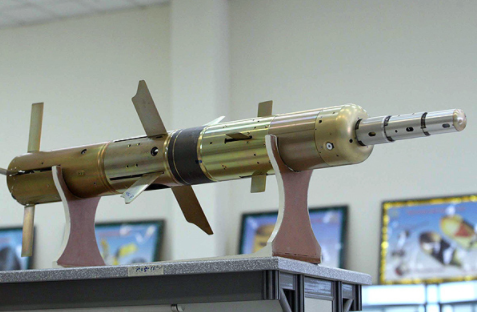
The Iran–Iraq war lead to Iran having an acute need for anti-tank guided missiles to counter Iraq's massive armored formations, leading Iran to import thousands more TOW missiles, as well as Soviet AT-3 Sagger ATGMs. Attempts at local production of both systems began in the first half of the war, with the TOW missile being prioritized due to its better performance.[2] The earliest prototype version was ready in mid-1985, but performance was disappointing compared to Iran's US-made TOW missiles, which received widespread praise in Iran at the time.[3] Following about a year and a half more of R&D work, the Toophan was tested against Iraqi tanks and showed better performance.[3][4] The missile was shown on an Iranian TV show on March 21, 1987,[3] and production of what would be named the Toophan 1 began by early 1988.[5] R&D and production work continued through the 1990s.[6] The missile was not publicly revealed until 2000, when the Toophan 1 and Toophan 2 were publicly unveiled at the same time.[7] The Toophan has since become Iran's primary anti-tank guided missile.[8]
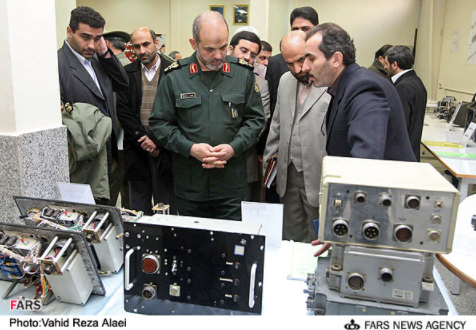
In addition to Toophan missiles, Iran also produces reverse engineered tripod launchers, guidance sets, and storage boxes, all of which bear the Toophan name.[9][10] Toophan missiles can be fired from TOW launchers, and their components are generally interchangeable.[11] A number of sources say that the Toophan's quality is inferior to that of original American-made TOW missiles, but is still robustly capable.[12]
In 2014 Iran showed a Toophan/TOW simulator they built for helicopter-launched missiles.[13] In a December 2016 military exercise Iran used the missile against naval targets.[14] In 2018 Iran showed off thermal-sights which can be used with the Toophan.[15] The Toophan can be mounted on Boragh APCs, ATVs,[16] or Safir jeeps.[17][18] Toophan missiles can be repaired by Iran's Shiraz Electronics Industries.[19]
The Toophan was later developed into the Sadid-1, an ambitious project to build a competitor to the Israeli Spike-ER fire-and-forget missile for attack helicopters and drones. The Sadid-1 had limited success, but was used to develop the successful Sadid-345 glide bomb, which in turn spun off a smaller counterpart, the Qaem air-to-ground munition.
2. Combat History
2.1. Iran–Iraq War
Prototype versions of the Toophan-1 were used in the tail end of the Iran–Iraq War.
2.2. 2006 Lebanon War
Hezbollah received Toophan missiles in the early 2000s and used them against Israeli Merkava tanks and other vehicles during the 2006 Lebanon War.[20][21]
2.3. Syrian Civil War
The Toophan missile has seen extensive use in the Syrian Civil War. Hezbollah has used Toophan missiles in the war[22][23] and is one of the missile's most prominent users. The missiles have also been provided to the Syrian Army and Iranian-backed Shiite militias in Syria. Toophan missiles first appeared in Syria reportedly in October 2015.[24] Overall the Toophan missile's use in Syria is poorly documented, but Toophan-1 missiles seem to be the most common. Furthermore, the Kurdish YPG militia has used Toophan 1 missiles as well.[25] The missiles have since proliferated to a wide range of non-state actors operating in Syria. In addition, Toophan missiles have been captured by groups fighting the Syrian government, including ISIS[26] and al-Nusra.
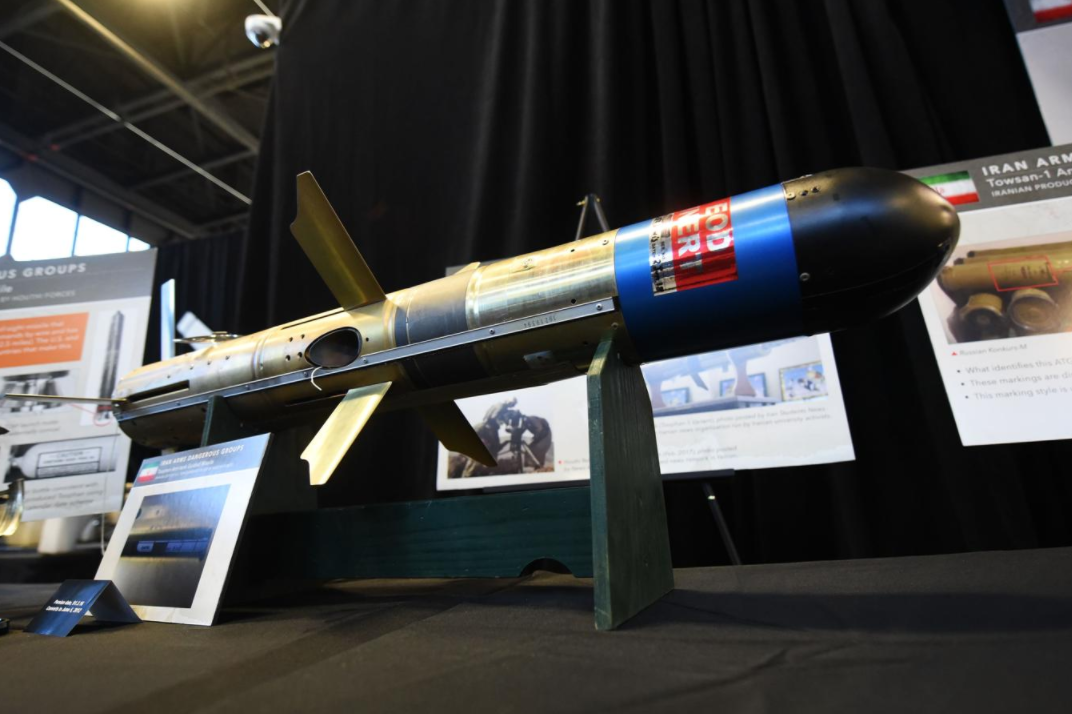
2.4. Iraqi Civil War
The first known Iraqi group to receive Toophans was Asaib-Ahl-Al-Haq in 2014.[27] The Badr Organization obtained Toophans in 2015 and the Toophan has since been provided to other Shiite militias organized under the Popular Mobilization Units.[28] Iraq's Federal Police have also been delivered Toophans.[29][30]
2.5. Yemen Civil War
Iran has shipped Toophan missiles to the Houthis in Yemen as well, where they have been used in combat.[31] The first video of Houthis using a Toophan missile was published in November 2018.[32]
3. Identification
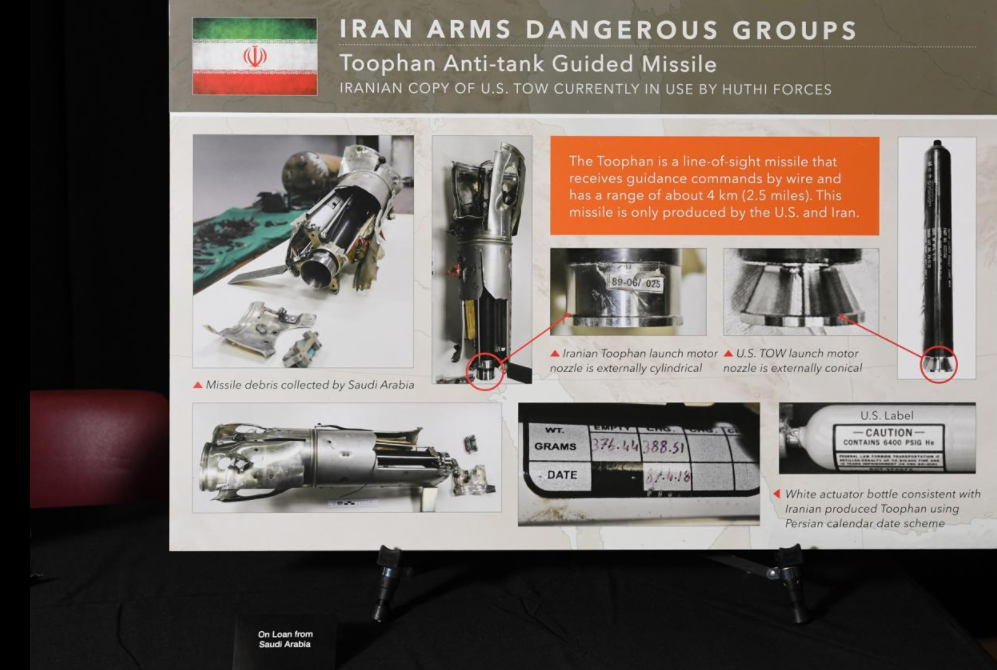
Identifying Toophan missiles is hard. The Toophan ATGM is very similar to the American BGM-71 TOW ATGM on which it is reverse engineered. Toophan missiles, launchers, control units, and crates are essentially interchangeable with their American counterparts and are regularly mixed together. The many variations of TOW and Toophan missiles also poses challenges.
Toophan missiles can often be identified by their turquoise bands installed by Iran's Defense Industries Organization[33] or by a faint black band on the rear end of the launcher.[34] Toophan missiles, on their packaging, are instead labeled as TOW missiles; for example a Toophan 2M is labeled as a "TOW 2M".[35]
Modern TOW tripods have black rings, while Toophan tripods have yellow rings.[28] Internally, Toophan missiles have different screw placement[36] and cylindrical launch motor nozzles.[37]
4. Variants
| Variant | Range | Penetration (RHA) | Length | Weight | Spec sheet | Notes |
|---|---|---|---|---|---|---|
| Toophan 1 | 3.5 km | 550 mm | 116 cm | 18.5 kg | [1] | BGM-71A TOW clone.[38][39] The Toophan-1's payload is a 3.6 kg HEAT warhead. The top speed 310 m/s. Exported to Hezbollah of Lebanon in the 2000s[35] and Iraqi forces in the Iraqi Civil War.[40] Toophan-1 marketing material claims a hit probability of 96%.[41] Entered production 1987/1988. |
| Toophan 2 | 3.5 km | 760 mm | 145 cm | 19.1 kg | [2] | Derivative of BGM-71C TOW missile[8][12] with a tandem HEAT warhead; possibly incorporates elements of BGM-71E TOW 2A missile.[42] Revealed in 2000. |
| Toophan 2B | 3.5 km | 900 mm | 145 cm | 19.1 kg | Upgraded Toophan 2 with heavier warhead.[43][44] Exported to Iraq and used in the Battle of Mosul.[45] | |
| Toophan 2M | 3.75 km | 650 mm | 147 cm | 21 kg | [46] Tandem warhead.[47] Exported to Iraq.[48] | |
| Toophan 3 | 3.5 km | 80 mm | 116 cm | 19.1 kg | [3] | Derivative of American BGM-71F TOW 2B top-attack missile[3] albeit with worse performance, introduced c. 2016.[49][50] Possibly exported to Hezbollah (Lebanon) and Kata'ib Hezbollah.[51] |
| Toophan 3M | Toophan 3 derivative with unknown changes. Top attack ATGM. Revealed in 2019.[52] | |||||
| Toophan 4 | 3.75 km | N/A | 117.2 cm | 20 kg | [4] (in Arabic) | Variant with thermobaric fuel-air warhead.[53] Exported to PMU forces in Iraq[54] and used in the battle of Mosul.[55] Also exported to Houthis in Yemen.[35] First shown to the public in 2017[56] but in use since at least 2015.[35] Like all Iranian thermobaric weapons, has a distinctive red band.[57] |
| Toophan 5 | 3.5 km | 900 mm | 145 cm | 19.1 kg | [5] (in Arabic) | Considered the premier Toophan variant,[3] the Toophan-5 has laser guidance, tandem-warhead[58] and canards.[43] Was apparently in development in 2002[59] and entered production in 2010.[60] Exported to Iraq[61] and used by Iraqi forces in Ninawa province and elsewhere.[62][63] As a laser-riding missile, it requires a different launcher.[57] Not a copy of any TOW variant.[8] |
| Qaem | Anti-helicopter variant with laser guidance and secondary flight motor. Mass production began in 2010.[60] | |||||
| Qaem-M (or Ghaem-M) | 6 km | N/A | 116 cm | 19.5 kg | [6] | Qaem variant with proximity fuze.[64] |
| Toophan 6 | 3.5 km | N/A | 117.2 cm | 21 kg | [7] | [65] Anti-bunker thermobaric warhead.[66] First shown to the public in 2017.[56] Perhaps laser-riding.[57][67] Unclear differences compared to Toophan-4.[3] |
| Toophan 7 | 3.75 km | 117.2 cm | 21 kg | [8] (in Arabic) | Unclear warhead, perhaps fragmentation thermobaric. |
5. Operators
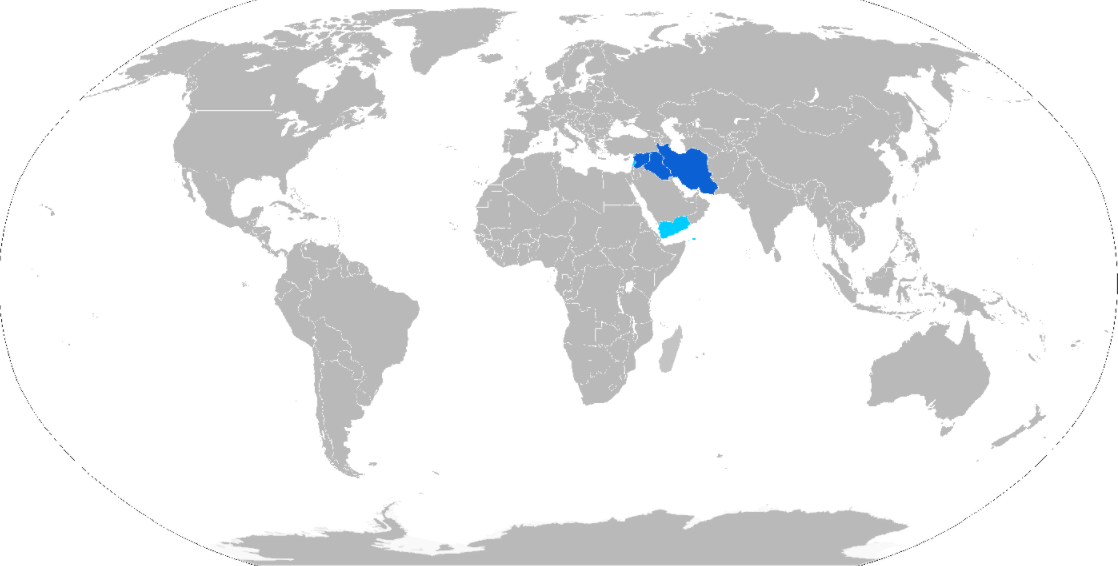
- Iran
- Syria
- Syrian Arab Army
- YPG[34]
- Unidentified Iraqi Shiite militias
- and others
- Iraq
- Iraqi Federal Police
- Popular Mobilization Units[69]
- Asa'ib Ahl al-Haq
- Badr Organization
- Saraya al-Salam
- Liwa Ansar al-Marja'iyya
- Harakat Hezbollah al-Nujaba
- Ansar Allah al-Awfiyya
- and others
- Palestine
- Al-Quds Brigades
- Yemen
- Lebanon
Hezbollah
The content is sourced from: https://handwiki.org/wiki/Engineering:Toophan
References
- Ann Tibbitts Schulz, Buying Security: Iran Under the Monarchy (San Francisco: Westview Press, 1989), pp. 57-58. ISBN:978-0813376615
- "Error: no |title= specified when using {{Cite web}}" (in fa). http://hamshahrionline.ir/details/177687.
- "Error: no |title= specified when using {{Cite web}}" (in fa). mashreghnews. https://www.mashreghnews.ir/news/797267/اعلام-رسمی-دستیابی-ایران-به-موشک-ضد-زره-با-سرجنگی-ترموباریک.
- "Error: no |title= specified when using {{Cite web}}" (in fa). 23 November 2014. https://www.mashreghnews.ir/news/365070/%D8%AA%D9%88%D9%81%D8%A7%D9%86-3-%D9%85%D8%B1%DA%AF%D8%A8%D8%A7%D8%B1%D8%AA%D8%B1%DB%8C%D9%86-%D9%85%D9%88%D8%B4%DA%A9-%D8%B6%D8%AF%D8%B2%D8%B1%D9%87-%D8%A7%DB%8C%D8%B1%D8%A7%D9%86%DB%8C-%D8%A8%D8%A7-%D8%B3%D8%B1%D8%AC%D9%86%DA%AF%DB%8C-%D9%88%DB%8C%DA%98%D9%87-%D8%B9%DA%A9%D8%B3.
- "Arms Deliveries to Iran and Self-Sufficiency". Defense Intelligence Agency. 24 February 1988. http://www.dia.mil/FOIA/FOIA-Electronic-Reading-Room/FOIA-Reading-Room-Iran/FileId/89383/.
- Lyamin, Yuri (5 October 2012). "Error: no |title= specified when using {{Cite web}}" (in ru). https://imp-navigator.livejournal.com/178035.html.
- "Another ATGW for Iran – Jane's Military Aerospace". 7 February 2003. http://www.janes.com/aerospace/military/news/jdw/jdw000526_2_n.shtml.
- Galen Wright, Iranian Military Capability 2011 – Ground Forces – March 15th 2011
- "Rocket and Missile – IRAN Defence Products". 22 September 2015. http://www.mindexcenter.ir/products-category/rocket-and-missile.
- "Toophan Missile Advanced Guaidance Set". IRAN Defence Products. http://mindexcenter.ir/product/toophan-missile-advanced-guaidance-set.
- Christopher F. Foss, "Iran offers new anti-tank missiles for export," Jane's Missiles & Rockets, 1 July 2000
- Sina Military (March 23, 2018). "Error: no |title= specified when using {{Cite web}}" (in zh-hans). http://mil.news.sina.com.cn/jssd/2018-03-23/doc-ifysnevm1378516.shtml.
- "رونمایی از شبیه ساز تاو و شینوک". 25 May 2014. https://www.mashreghnews.ir/news/312740/%D8%B1%D9%88%D9%86%D9%85%D8%A7%DB%8C%DB%8C-%D8%A7%D8%B2-%D8%B4%D8%A8%DB%8C%D9%87-%D8%B3%D8%A7%D8%B2-%D8%AA%D8%A7%D9%88-%D9%88-%D8%B4%DB%8C%D9%86%D9%88%DA%A9.
- "New Interceptor Missiles Fired in Iran Military Drill". Tasnim News Agency. 12 December 2016. https://www.tasnimnews.com/en/news/2016/12/12/1265342/new-interceptor-missiles-fired-in-iran-military-drill.
- "Iran Builds Thermal Imaging Infrared Cameras (+Photos) – Tasnim News Agency". https://www.tasnimnews.com/en/news/2018/01/26/1638573/iran-builds-thermal-imaging-infrared-cameras-photos.
- Lyamin, Yuri (24 May 2012). "Error: no |title= specified when using {{Cite web}}" (in ru). https://imp-navigator.livejournal.com/162958.html.
- Lyamin, Yuri (20 February 2017). "Error: no |title= specified when using {{Cite web}}" (in ru). https://imp-navigator.livejournal.com/583238.html.
- "A l'encontre » Syrie. Alep: les milices chiites en première ligne" (in fr). December 8, 2016. https://alencontre.org/moyenorient/syrie/syrie-alep-les-milices-chiites-en-premiere-ligne.html.
- "Adam Rawnsley on Twitter". https://twitter.com/arawnsley/status/831261301271846912.
- Mikhail Barabanov, scientific editor of Arms Export (2006-08-23). "Hezbollah's Examination". Kommersant. http://www.kommersant.com/p698954/Hezbollah%E2%80%99stic_Examination/.
- Hamid Reza Ghorbani. "Error: no |title= specified when using {{Cite web}}" (in fa). https://www.yjc.ir/fa/news/5823736/موشک-توفان-گردبادی-که-در-33-روز-اسرائیل-را-شخم-زد.
- Zimmt, Raz (February 14, 2016). "Spotlight on Iran (January 31 – February 14, 2016)". The Meir Amit Intelligence and Terrorism Information Center. http://www.terrorism-info.org.il/Data/articles/Art_20957/E_032_16_1431775832.pdf.
- ابنا, اختصاصی (31 January 2016). "Error: no |title= specified when using {{Cite web}}" (in fa). AhlulBayt News Agency (ABNA). http://fa.abna24.com/service/middle/archive/2016/01/31/696868/story.html.
- "Ivan Sidorenko on Twitter: "#Syria Iranian Toophan was first seen in Aleppo Region about October 13th, 2015 - #Iran #Shia #Shiite #Iraq #Iraqi – "". 7 September 2016. https://twitter.com/ivansidorenko1/status/677659697487441921.
- "Kurdish YPG fire Iranian-made missile at Turkish Army decoy (video)". 30 January 2018. https://www.almasdarnews.cohm/article/kurdish-ypg-fire-iranian-made-missile-turkish-army-decoy-video/.
- Aldin. "#ISIS in #Iraq using #Iran Toophan ATGM to destroy #ISF HUMVEE near Shirqat.". twitter.com. https://twitter.com/aldin_ww/status/749591249615814656.
- "The discreet use of BGM-71 TOW ATGM in Iraq points to Iran". https://aerohisto.blogspot.ae/2015/07/the-discreet-use-of-bgm-71-tow-atgm-in.html.
- Rawnsley, Adam (June 18, 2016). "Iranian TOW Missile Knockoffs Spread to War Zones". War is Boring. https://warisboring.com/iranian-tow-missile-knockoffs-spread-to-war-zones/.
- O'Neill, Kara (31 March 2016). "Iraqi soldiers celebrate after foiling ISIS car bomb attack with missile". https://www.mirror.co.uk/news/world-news/iraqi-soldiers-celebrate-after-foiling-7663118.
- ali javid (7 April 2016). "Toophan ATGM missile used by resistance in Iraq to take out terrorist suicide car bomber". https://www.youtube.com/watch?v=vz58SPFcYjs.
- Jim Garamone. "DoD Shows Iranian Weapons as Proof of Tehran’s Duplicitous Ambitions". DoD News, Defense Media Activity. https://www.defense.gov/News/Article/Article/1396769/dod-shows-iranian-weapons-as-proof-of-tehrans-duplicitous-ambitions/.
- Lyamin, Yuri (30 Nov 2018). "Error: no |title= specified when using {{Cite web}}" (in ru). https://imp-navigator.livejournal.com/781220.html.
- Lyamin, Yuri (25 July 2015). "Error: no |title= specified when using {{Cite web}}" (in ru). https://imp-navigator.livejournal.com/351697.html.
- Lyamin, Yuri (31 January 2018). "Error: no |title= specified when using {{Cite web}}" (in ru). https://imp-navigator.livejournal.com/701712.html.
- Lyamin, Yuri (10 May 2016). "Error: no |title= specified when using {{Cite web}}" (in ru). https://imp-navigator.livejournal.com/459037.html.
- "DVIDS – Images – Evidence Shows Iranian Weapons Proliferation [Image 31 of 68"]. 29 December 2017. https://www.dvidshub.net/image/4029698/evidence-shows-iranian-weapons-proliferation.
- Photo by EJ Hersom (January 24, 2018). "Iranian Weapons Proliferation Evidence". https://www.dvidshub.net/image/4095666/iranian-weapons-proliferation-evidence.
- "Archived copy". http://mindexcenter.ir/product/basic-toophan-heavy-anti-armor-guided-missile.
- "Army Reconn article on Iranian copies of DRAGON and TOW". http://www.armyrecognition.com/forum/viewtopic.php?t=451.
- KLKAMASH. "Toophan 1 and Toophan 4 #Iraq". https://twitter.com/klkamashiq/status/915140549358817280.
- "Anti Tank Missile Launcher, TOOFAN-1 – ieimil.ir". 7 August 2011. http://www.ieimil.ir/content/anti-tank-missile-launcher-toofan-1.
- "Archived copy". http://mindexcenter.ir/product/toophan-2-heavy-armor-guided-missile.
- "iranmilitaryforum.net". http://www.iranmilitaryforum.net/wiki/index.php?title=Toofan_ATGM.
- "Index – The First Military Reference Forum Site in Iran". military.ir. http://www.military.ir.
- KLKAMASH (25 March 2017). "Toophan-2 B #mosul #Iraq". https://twitter.com/klkamashiq/status/845650755235319808.
- "Iranians Mark Anniversary of Islamic Revolution with Nationwide Rallies". https://english.almanar.com.lb/443848.
- "Error: no |title= specified when using {{Cite web}}" (in fa). Tasnim. https://www.tasnimnews.com/fa/news/1396/11/22/1653803/22-%D8%A8%D9%87%D9%85%D9%86-96-8-%D8%AC%D8%AF%DB%8C%D8%AF%D8%AA%D8%B1%DB%8C%D9%86-%D9%85%D9%88%D8%B4%DA%A9-%D8%B6%D8%AF%D8%B2%D8%B1%D9%87-%D8%A7%DB%8C%D8%B1%D8%A7%D9%86%DB%8C-%D8%A8%D8%A7-%D9%86%D8%A7%D9%85-%D8%AA%D9%88%D9%81%D8%A7%D9%86-2-m-%D8%B1%D9%88%D9%86%D9%85%D8%A7%DB%8C%DB%8C-%D8%B4%D8%AF-%D8%B9%DA%A9%D8%B3.
- KLKAMASH. "Toophan 2M or TOW-2M #Mosel #Iraq". https://twitter.com/klkamashiq/status/851462410884042757.
- Galen Wright. "Iran shows Toophan-3 anti-tank guided weapon at Baghdad arms expo". Armament Research Services. http://armamentresearch.com/iran-unveils-toophan-3-anti-tank-guided-weapon-at-baghdad-arms-expo/.
- "Archived copy". http://mindexcenter.ir/product/toophan-3-heavy-anti-armor-guided-missile.
- Michael Knights, 30-Sep-2011. Shia strength – Iraqi militants adapt to the US drawdown. Jane's Intelligence Review, Terrorism and Insurgency. IHS Global Limited.
- "Archived copy". https://www.tasnimnews.com/en/news/2019/01/30/1935262/iran-unveils-new-anti-armor-missiles.
- KLKAMASH. "pic.twitter.com/eDlGXsZG0K". https://twitter.com/klkamashiq/status/844920490909143040.
- lemon, Green. "#Iraq Clear picture of Iranian "TOW 4" ATGM carte. Probably a Toophan 4 variant. h/t @IraqiSecurity". https://twitter.com/green_lemonnn/status/844898084681338880.
- KLKAMASH. "Toophan-4 in #mosul #Iraq #Iran #ISIS". https://twitter.com/klkamashiq/status/844917702649090050.
- Babak, Sheykh. "Misagh MANPAD & Toophan anti tank missile family. Toophan 4 & 6 were seen here for the first time.". https://twitter.com/MuslimTurk1/status/839010883292528640.
- Lyamin, Yuri (24 March 2017). "Error: no |title= specified when using {{Cite web}}" (in ru). https://imp-navigator.livejournal.com/597697.html.
- KLKAMASH (25 March 2017). "Toophan-5 tandem warhead / Toophan-6 Thermobaric / Toophan-7 High Explosive -TFT". https://twitter.com/klkamashiq/status/845882615227928576.
- Jane's Armor and Artillery (2002)
- "Iran: Qaem, Qaem-2 and Toophan-5 missiles". http://www.tacticalreport.com/view_news/Iran:_Qaem_Qaem-2_and_Toophan-5_missiles/1065.
- Inbar, Tal (29 June 2016). "Iran delivers "Toophan 5" anti-tank missile systems to Iraqi Armed Forces. @UANI @ReutersIran @OpallRome". https://twitter.com/inbarspace/status/748113542310666241.
- Sumeri, Haidar. "Iranian Toophan-5 ATGM being used by #Iraq's Federal Police in Ninawa ops.". https://twitter.com/IraqiSecurity/status/819299563253198848.
- Sumeri, Haidar. "#Iraq's Federal Police have received Toophan-5 ATGMs from #Iran. Good weapon for dealing with VBIEDs.". https://twitter.com/IraqiSecurity/status/749425126157025280.
- Lyamin, Yuri (20 July 2017). "Error: no |title= specified when using {{Cite web}}" (in ru). https://imp-navigator.livejournal.com/637994.html.
- Threat Tactics Report: Iran (Jun 2016) Version 1.0
- KLKAMASH. "TOOPHAN- 6 #Iraq #Iran أرشيف معرض الأمن والدفاع 2017 / بغداد". https://twitter.com/klkamashiq/status/915493603903983616.
- "Error: no |title= specified when using {{Cite web}}". https://www.facebook.com/ng.wawos/posts/872265396245354.
- Ali Nuri Zadeh (1 August 2001) "Upon Regional and International Pressure, Iran Scales Down the Production of Ballistic Missiles and Focuses on Shorter Range and Better More Accurate Weapons; Iran Announced a Successful Test of Anti- Armor Saeqeh-1 Missile," Al-Sharq al-Awsat (London)
- "Iraq: Turning a blind eye: The arming of the Popular Mobilization Units". Amnesty International. 5 January 2017. https://www.amnesty.org/download/Documents/MDE1453862017ENGLISH.PDF.
- Galen Wright (October 1, 2015). "Saudi-led Coalition seizes Iranian arms en route to Yemen – Armament Research Services". Armament Research Services. http://armamentresearch.com/saudi-led-coalition-seizes-iranian-arms-en-route-to-yemen/.
